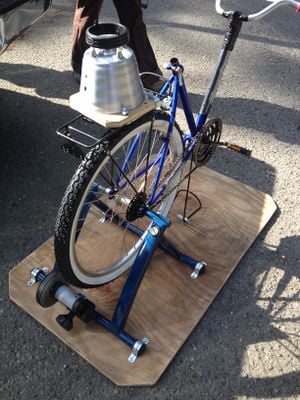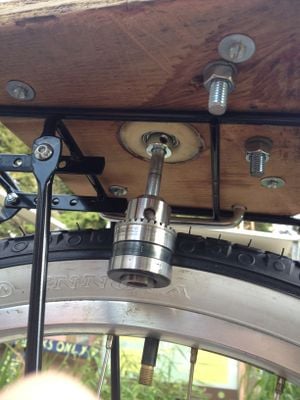No edit summary |
|||
| Line 1: | Line 1: | ||
==Background== | ==Background== | ||
Revision as of 05:36, 17 May 2015
Background

Students Bryce Goldstein and Carley Bramhill are working on building a bicycle-powered blender to be used and displayed at CCAT, located at Humboldt State University in Arcata, California, United States of America. The project is part of Lonny Grafman’s ENGR 305 Appropriate Technology class in Spring semester 2015. CCAT’s original bike blender was built in 1997 by Bart Orlando with the help of students, and it was used at CCAT and campus-wide events. Unfortunately, this icon of appropriate technology has since been broken and lost. CCAT would like to have another bike blender built to demonstrate the use of pedal power.
Problem statement
The objective of this project is to design a bicycle powered blender, to be displayed and utilized at the Campus Center for Appropriate Technology (CCAT), at Humboldt State University in Arcata, California, USA. This iteration will be mechanical in design, translating the momentum generated by pedaling the bicycle directly to the operation of the blender. The intention is to keep the design as simplistic as possible, in order to improve efficiency, as well as ensure that any future maintenance can be performed by any adult, with or without mechanical expertise.
Project Evaluation Criteria
The following criteria will be used to evaluate potential designs and choose the most appropriate one for this project. These criteria were chosen based on the suggestions of our CCAT contact on this project, Julian Quick, as well as Bart Orlando, who is kindly assisting as an external adviser. The scale (1-10) represents the weight of consideration (from least to most) for each of the listed criteria.
| Criteria | Constraints | Weight (1-10) |
|---|---|---|
| Functionality and Stability | When pedaled, the blender should stay firmly in place, while blending fruit and ice in a reasonable amount of time. | |
| Safety | Must be safe to operate, including both blender and bike sections. | |
| Education | Must demonstrate the use of pedal power. | |
| Ease of Use | Can be operated by one person without assistance. | |
| Maintainability | A person with low-average mechanical skills should be able to maintain and repair it. | |
| Cost | Must cost less than retail for commercial alternatives. | |
| Reproducibility | Design should be relatively simple, using easily acquired components. | |
| Aesthetics | Must look appealing enough to display. |
Literature Review
This should be a review of the available literature pertinent to the CCAT Bike Blender 2015 but I couldn't get the reference links to work.
Bike Blender Basics
Pedal power is useful because bicycles are designed to hold a large amount of weight and transfer humans' kinetic energy into low-friction mechanical energy. One purpose of a bike blender is to replace an energy-intensive regular blender with a more sustainable method of making smoothies. A bike-powered blender can also be used as an educational tool as well as an appliance. It can demonstrate the use of pedal power, and also get kids interested in healthy living.
Bike Blender Concerns
A bike-powered blender may sound like a silly idea to some. Why would we put energy and resources into an appliance that only has one function? We are building the bike blender as a way to demonstrate the alternative uses of bicycle parts and human power, rather than make a product that would be desirable to everybody. Also, electric-powered blenders run off of grid electricity, which is typically generated from non-renewable sources such as coal or natural gas.
Types of bike blenders
The are multiple types of bike blenders. There are advantages and disadvantages to each, as described below.
Mechanical
Mechanical bike blenders use mechanical energy to run the blender directly, as opposed to running a motor. Mechanical bike blenders generally have less parts and are easier to maintain without advanced knowledge.
Electrical
Electrical bike blenders convert mechanical energy into electrical energy to run the blender.
Stationary versus Mobile
Our bike blender is mobile, meaning that the bicycle can be ridden as a normal bike if the blender stand is removed. Some bike blenders are stationary, meaning that the whole system is built to be pedaled in place. Because ours is intended for display and education, we at first decided that a stationary bike would be easier to build and would be sturdier. Another advantage of the stationary bike blender is that we can attach a table or tray to the front of the system so that the operator can set down materials that are to be blended. However, our clients decided that a mobile blender would better suit their needs, so that is what we are building.
Designing interpretive materials
CCAT did not ask for any interpretive materials. Based on other projects at CCAT, it could be beneficial to have a sign explaining how to operate it safely and why it is relevant to appropriate technology and the purpose of CCAT.
Proposed timeline
This timeline will provide us guide so we know what we should be working on at a certain time. It will also allow our client, CCAT, a glimpse at how we plan to accomplish our project goals within the time allowed. It is only a loose timeline for now; we will update as we go along.
| Week of semester (date) | Task | Description |
|---|---|---|
| 1 (January 19 2015) | Project options pitched | Lonny told us about the options for projects |
| 2 (Jan. 26) | Project selection, teams formed | We chose the bike blender and went to CCAT to begin research |
| 3(Feb. 2) | Explore options and site of project | We went to CCAT to look at their bike parts and talk to employees about criteria and specifications. |
| 4 (Feb. 9) | Further research | We went to CCAT to test their stationary bike parts for functionality. We also learned where their tools and materials are kept. |
| 5 (Feb. 16) | Pitch design options to client | We presented the options - stationary "smoothie bar" or detachable, portable pedal blender - to CCAT and they chose the latter. |
| 6 (Feb. 23) | Research mobile blenders | Do further research, focusing on stability and ease of attachment to various bike models. Also figure out costs and budget. |
| 7 (Mar. 2) | Design, gather materials | Make plans and designs. Go shopping, order things, continue research. |
| 8 (Mar. 9) | Start building | Continue acquiring parts and begin putting things together. |
| 9 (Mar. 23) | Build and troubleshoot | By this time we should have started putting the pieces together and have an idea of what won't work. |
| 10 (Mar. 30) | Testing and troubleshooting | Continue building, be frustrated. |
| 11 (Apr. 6) | Design interpretive materials | Make plans for signage, instructions, etc. |
| 12 (Apr. 13) | Various work | Tweaking blender design, if necessary, designing and getting materials for interpretive materials. |
| 13 (Apr. 20) | Various work | Building blender, creating interpretive materials. |
| 14 (Apr. 27) | Complete blender | The blender should be completed at this time. Work on interpretive materials. |
| 15 (May 4) | Complete interpretive materials | Finishing touches to blender and interpretive materials. |
| 16 (May 11) | Have everything completed | Make things pretty and presentable |
Costs
This is our proposed budget for the project. It only includes rough estimates of the costs for materials based on prices we found online. CCAT has a $200 budget for our project, so we need to have the total cost be under this amount. Additionally, a commercial version of this device currently retails at $250. So, the optimal cost of production for our version should be well below that value.
| Quantity | Material | Source | Cost ($) | Total ($) |
|---|---|---|---|---|
| 1 | Blender | Thrift Shop | 6.00 | 6.00 |
| 1 | Bike storage rack | Retail | 22.00 | 22.00 |
| 1 | Strap/bungee cord | Retail | 10.00 | 10.00 |
| 1 | Bike trainer stand | Ebay | 50.98 | 50.98 |
| assorted | nuts/bolts/etc | Hardware store | 10.00 | 10.00 |
| assorted | wood | most likely scrap | 0.00 | 0.00 |
| 1 | Skateboard wheel | scrap / skate shop | 0.00 | 0.00 |
| Total Cost | $98.98 | |||
Construction
We built the bike blender using the materials listed above. We began construction by taking apart blenders to find out how they worked, followed by cutting a piece of plywood to fit over the bike rack and drilling a hole in the wood. A skateboard wheel was put inside this hole to keep the shaft in place. The shaft is constructed of a long rod. One end of the shaft has a piece to connect to the blender/pitcher and make the blades spin. The other end has a drill chuck attached. This drill chuck pushes against the bicycle wheel, causing it to spin when the bike is pedaled. The spinning in turn rotates the blades very quickly. We got the idea to use a drill chuck from Foodshare.net's video about building your own bicycle blender [1].

Operation
Instructions
To operate the bike blender, the back wheel of the bicycle must first be put up on the stand. The blender assembly rack must be attached to the back, with the drill chuck drive shaft pressed against the left side of the tire. Secure the base to the rack with the strap. Place the pitcher on the base. Place food you wish to blend inside the pitcher and secure the lid. Get on the bike and start pedaling, and the blender will start working.
Maintenance
The bike blender will need to be stored in a location where it will not rust. Also, the blender/pitcher component must be washed after use.
Conclusion
In the end, we created a very cool bike-powered blender that didn't cost very much money or take a lot of specialized experience or tools. The hardest part was trying to find a cylindrical piece to transfer the rotation of the bike wheel to the rotating axis of the blender. Also, we tried to make our design a little bit different than all the previous ones, so we didn't have any specific instructions to rely on.
Team
Spring 2015
- Bryce Goldstein
- Carley Bramhill
References
1. Bart Orlando
2. Hazeltine and Bull, "Field Guide to Appropriate Technology" pp. 612-614
3. Congdon, R.J. 1977. "Introduction to Appropriate Technology - Toward a Simpler Lifestyle." Rodale Press.
4. Pedal Power Binder at CCAT
5. Paul, Terrance D. "How to Design and Build and Independent Power System" 1981, Best Energy Systems for Tomorrow, Inc.
6. McCullagh, James C. "Pedal Power in Work, Leisure, and Transportation"
7. Grose, Thomas. 2009. Pedal Power. ASEE Prism. 18, no. 8: 16.
8. 2007. Bicycle Blender Means a Quick Ride for a Drink: 2 Edition. The Nelson Mail. 15-14.
9. 2014. Arizona 4-H and UnitedHealthcare Expand "Eat 4-Health" Partnership; Use "Pedal Power" to Help Youth Tackle Obesity and Encourage Healthy Lifestyles. Hospital Law Weekly. 3.
10. FoodShare's "Build Your Own Bicycle Powered Blender" video [1]
11. Bike Rodeo bicycle blender
12. Public Health Bike Blender
- ↑ 1